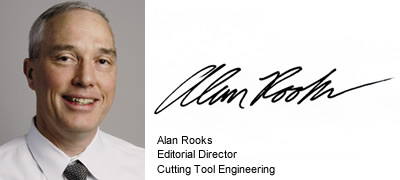Good morning AM
Good morning AM
Is it morning in America -- and the world -- for additive manufacturing? That's looking more and more likely. While AM, also known as 3D printing, is well-established as a process for making prototype parts, it's making serious inroads into production -- where the real money is.
Is it morning in America—and the world—for additive manufacturing? That's looking more and more likely. While AM, also known as 3D printing, is well-established as a process for making prototype parts, it's making serious inroads into production—where the real money is.
AM appears to be much farther along for production applications now than it was even a few months ago. I say that in part to justify writing about AM again since focusing on it in my September Lead Angle. Normally, I don't like to repeat topics that often, but I'm making an exception because of several game-changing events.
While many companies have been using 3D printing to make prototype parts, major manufacturers, including Airbus, General Electric and Siemens, are using it to develop high-value production parts. Siemens began making 100 types of spare parts and other gas turbine components via AM in January, reducing repair times by 90 percent in some cases, according to a report in the Financial Times, "3D printing reshapes the factory floor."
In the report, Nicolas Vortmeyer, CTO for Siemens' power generation division, said 3D printing could revolutionize the supply of spare parts. Typically, they are mass produced, stored and shipped. Instead, Siemens is printing them wherever they are needed.
Likewise, the aerospace industry is using 3D printing to make lighter parts with reduced material waste compared to traditional subtractive machining. For example, GKN, a U.K.-based automotive and aerospace parts maker, is developing a titanium bracket with Airbus that can be 3D-printed in 40 minutes compared to 4 hours via machining, while cutting material use by 30 percent, according to the report.
In North America, GE Aviation is ramping up to produce a key fuel injector nozzle via direct metal laser sintering for the LEAP jet engine it is co-developing for the Boeing 737 MAX and the Airbus A320neo aircraft. Each engine will contain 19 fuel nozzles, and GE plans to produce 100,000 of the parts by 2020.
These and other manufacturers are tapping into a clear trend toward 3D-printed production parts. According to the 2013 Wohlers Report, produced by AM consulting firm Wohlers & Associates, Fort Collins, Colo., final part production represented 28.3 percent of the $2.2 billion spent in 2012 on AM products and services worldwide. In 2003, it represented only 3.9 percent of revenues.
Machine shops in the U.S. have already added 3D printing to their equipment lists. For example, Baklund R&D LLC, Hutchinson, Minn., is producing tool and die equipment via 3D printing, according to a Bloomberg report. Owner Jon Baklund said the shop has doubled its business via 3D printing.
Bloomberg reported that hundreds of other small U.S. operations are also investing in 3D printing. For example, identity verification company SnowShoe, Madison, Wis., is using three low-cost MakerBot Replicator 2 3D printers to make small plastic stamps that are pressed on a cellphone or tablet screen to verify identity. Previously, the stamps were milled from aluminum.
Traditional machine builders are taking notice of this trend as well. MC Machinery Systems Inc., a unit of Mitsubishi Corp., is distributing the new LUMEX Avance-25—a hybrid metal laser sintering and milling machine made by Matsuura Machinery Corp. of Japan—in North America. According to MC Machinery, the machine can make complex dies and molds in one piece with shorter lead times, reducing manufacturing costs by as much as a third compared to conventional methods. Machine tool builder DMG Mori plans to release a similar hybrid machine at IMTS 2014.
Of course, AM will not be completely eliminating traditional machining anytime soon. In some instances, AM materials can be 50 to 100 times more expensive than traditional manufacturing materials, according to Wohlers Associates, and AM remains a significantly slower process than machining, with the titanium bracket being an exception. But having heavyweights like GE and Siemens producing AM parts—as well as small shops—should get everyone's attention. It's certainly looking like the sun is shining on AM. CTE


